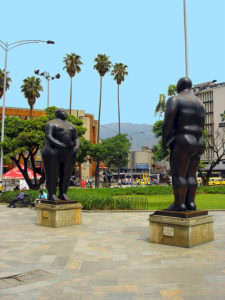Starting last week, some of Rome’s public squares will feature the work of the late, great Colombian painter and sculptor Fernando Botero.
The Botero a Roma exhibition features eight large sculptures on display in the public spaces of Rome’s historic center. The Fernando Botero Foundation is putting it on along with several Italian cultural organizations like Il Cigno Arte, Il Cigno GG Edizioni, and BAM Eventi d’arte. The exhibition includes Standing Man (Adamo) and Standing Woman (Eva) in the Piazza del Popolo, Horse with Bridle just off the Via del Corso, and Cat in front of the Basilica di San Lorenzo in Lucina. While his work is often remembered for its subjects’ exaggerated voluptuousness, there’s more to Botero than making things look fat. Botero explored the sensuality of their form by playing with the size and shape of people and animals.
Italy had special meaning for Botero, as he traveled there at age twenty following his first solo show in Bogotá. There, he studied the Italian Old Masters, combining their influence with the indigenous and colonial Spanish elements in his work. He would return to Italy in the 1970s, where he undertook new sculpture projects, which he exhibited at the Grand Palais in Paris in 1977. Though he lived mainly in Paris and Monte Carlo, Botero also had a house in the Tuscan town of Pietrasanta. The town has long been known as the region’s cultural and artistic hub, particularly for sculptors. The area’s marble quarries and those of nearby Carrara are considered some of the best in the world. Artists ranging from Michelangelo to Henry Moore have visited, worked in, and lived in Pietrasanta. One of the last sculptural shows for Botero’s work before the ongoing Rome exhibition was held in Pietrasanta to commemorate the artist’s eightieth birthday in 2012.
Other works are publicly viewable at the Terrazza del Pincio, the Largo dei Lombardi, the Piazza Mignanelli, and the Piazza San Silvestro. The artist’s daughter, Lina Botero, helped curate the exhibition. “From every point of view, Italy was his second homeland, not only for the admiration he had for its art but the love he felt for what he also considered his homeland.” Botero passed away last year at the age of 91, with his ashes buried in Pietrasanta. Therefore, the Botero a Roma exhibition seeks to continue his works’ “permanent celebration of life”. It does seem somewhat ironic, though. In a place so full of public monuments and sculptures, to draw attention with the addition of more public sculptures is an impressive feat. Botero’s monumental sculptures will be on display throughout Rome until October 1st.

